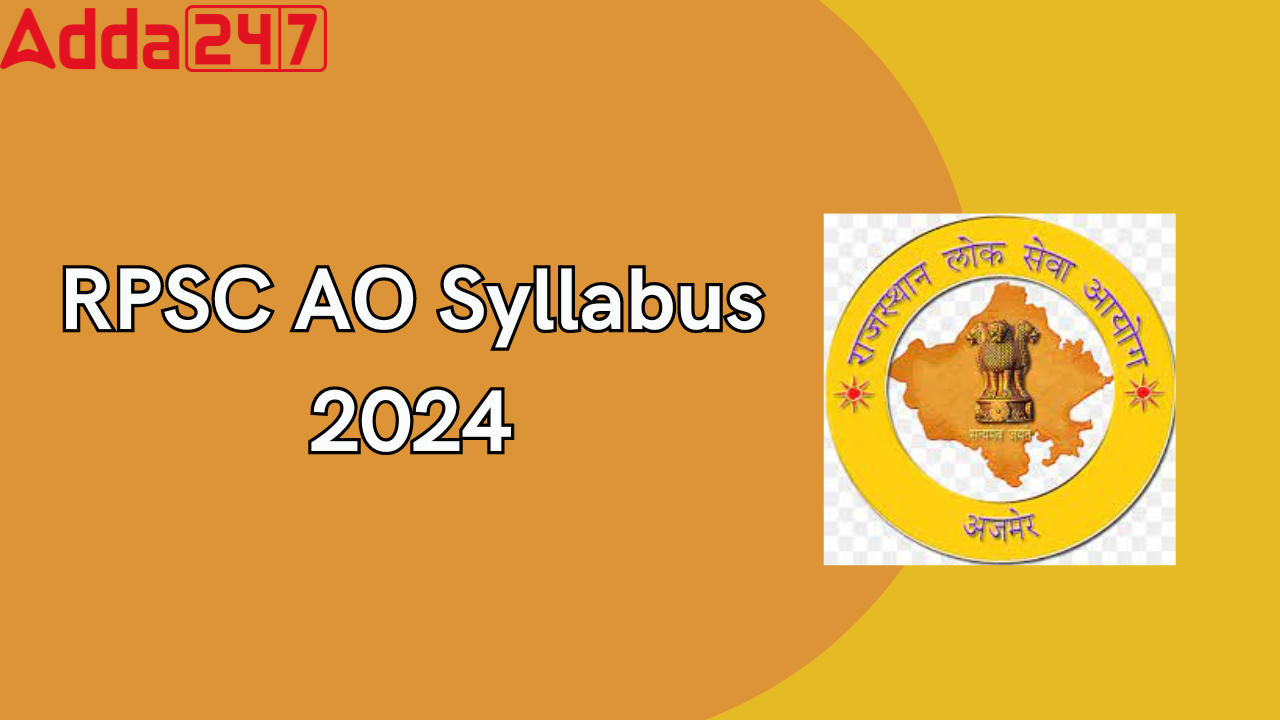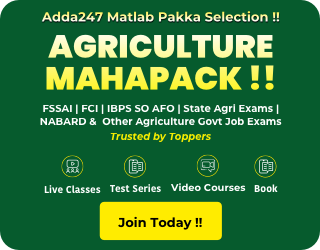Table of Contents
RPSC Agriculture Officer Syllabus 2024
The Rajasthan Public Service Commission (RPSC) has closed the application process for the Agricultural Officer position under the RPSC AO Vacancy 2024, with 25 positions available. Candidates who applied can now prepare for the upcoming examination. The exam pattern and syllabus for the RPSC Agriculture Officer 2024 are provided on this page to assist with your preparation. The exam date will be announced soon, so candidates should stay updated for further details. Reviewing the exam pattern and syllabus thoroughly will be essential for effective preparation.
RPSC Agriculture Officer Exam Pattern 2024
The RPSC Agriculture Officer Exam Pattern for the written test is outlined below. Review the table to understand the marking scheme, number of questions, and other key details for the upcoming RPSC Agriculture Officer Exam 2024:
| RPSC Agriculture Officer Exam Pattern 2024 | |
| Post | Agriculture Officer |
| Exam mode | Offline |
| Questions | 150 |
| Time | 2:30 Hours (150 minutes) |
| Marks(TOTAL) | 150 |
| Marking Scheme | 1 mark for every right answer |
| Negative Marking | 1/3 deduction for every wrong answer |
RPSC Agriculture Officer Syllabus
The RPSC Agriculture Officer Exam will consist of a single paper with two distinct sections, totaling 150 minutes.
- Part A: General Knowledge of Rajasthan
- Part B: Subject-specific content based on the qualifications required for the position
For detailed information on the syllabus for each section, please refer to the RPSC Agriculture Officer Syllabus below.
RPSC Agriculture Officer Syllabus
PART-A
History, Culture & Heritage of Rajasthan
- Pre- and Early Rajasthani History
- Rajasthan’s major dynasties and notable rulers’ accomplishments throughout the Rajput era.
- The 19th-century socio-political awakening, the 20th-century peasant and tribal movements, the 20th-century political struggle, and Rajasthan’s integration are the factors that contributed to the emergence of modern Rajasthan.
- Rajasthan’s visual arts include the architecture of its temples and forts, its sculptures, and its numerous painting schools.
- Rajasthani folk dance and drama, as well as folk music and instruments, are examples of the state’s performing arts.
- Rajasthani folk deities, saints, and other religious cults.
- The distribution of Rajasthani dialects; Rajasthani language literature.
Geography, Natural Resource & Socio-Economic Development of Rajasthan
- Rajasthan’s geography includes the following broad physical features: major rivers and lakes; mountains, plateaus, plains, and deserts; climate and agroclimatic zones; principal soil kinds and their locations; principal forest types and their locations
- Features of the Demographic
- Deforestation, environmental pollution, droughts and floods, desertification, and ecological concerns.
- The main agricultural industries of Rajasthan include textile, sugar, paper, and vegetable oil. The state’s economy also includes agro-food parks, unemployment and poverty, and both renewable and nonrenewable power resources.
Part B
Agriculture Syllabus
UNIT I
- Rajasthan and India’s agroclimatic zones.
- Climate, weather forecasting, and remote sensing.
- Cutting-edge ideas in agricultural productivity.
- Soil: kinds, reactions, interactions, and qualities
- Coordinated weed control
- Issues related to soil erosion in arid and semi-arid areas.
- Conservation of soil and water through agronomic methods.
- Systems of integrated farming and integrated watershed management.
- Organic gardening.
- Agriculture on dry land
- The practice of agroforestry
- Important crop agronomy: cereals, oilseeds, pulses, fiber crops, pasture crops, sugarcane, sugar beet, and potatoes.
- Indian and Rajasthani soils
- Nutrition of Plants
- Erosion of Soils
- The function of soil microorganisms.
UNIT II
- Fruit science and horticulture, with particular emphasis on Rajasthan
- Floriculture and High-Tech Horticulture
- Nursery Cultivation PHT: – Significance; Fruits and Vegetable Preservation
- Principles and Techniques; Maturity Indexes; MAS, CAS; Canning; Packing Techniques.
- Preparing pickles, preserves, dehydrated goods, jam, jelly, sauces, and ketchup.
criteria for food safety.
UNIT III
- Center of origin, Cell, and cell division
- Plant heredity, inheritance, and Mendelian principles
- Characteristics of Quantitative and Qualitative Plant Breeding
- Important Crops’ Plant Genetic Resources
- Crop evolution
- Breeding in Abiotic and Biotic Conditions
- Brand Marker Helped choose
- Varieties, IPR, PPV, and FR Act release and notification.
- Plant Genetics
- Seed Act, Seed Control Order, and Seed Production of Important Crops
- DNA combining skills, recombinant technologies, transgenic crops, and their application.
- Tissue culture and micropropagation techniques.
- Genetic Variation at the Molecular Level
UNIT IV
- Chemistry of proteins, fats, carbohydrates, and phytohormones from plants.
- The properties and applications of nucleic acids.
- Overview of the metabolism of fat, protein, and carbohydrates.
- Overview of secondary metabolites, coenzymes, and enzymes.
- Give a brief overview of plant biotechnology and plant tissue culture.
- Molecular markers and agricultural applications of them.
- Both photorespiration and photosynthesis.
- Breathing
- The mechanisms of blossoming
- The photoperiod
- Growth physiology, PGRs, and their function
- Growth, germination, and dormancy of seeds.
UNIT V
- The economic contribution of livestock and poultry in Rajasthan.
- The Rajasthani government launched policies and programs for livestock development.
- Significant native, hybrid, and foreign animal and poultry breeds. Systems for raising livestock and animal migration in Rajasthan.
- The behavior of livestock and the maintenance of their shelter
- Principles related to housing, sanitation, and hygiene.
- Handling various animal classifications
- Management of milking and milk synthesis.
- Rajasthan’s conventional and non-conventional feed and fodder resources and their nutritional worth
- Creating hay and silage, whole feed blocks, and banks of fodder.
- Important viral and non-infectious diseases affecting poultry and animals, along with preventative and remedial actions.
- Techniques to lessen the effects of climate change on the production of poultry and animals.
UNIT VI
- What part do fungi, nematodes, viroids, phytoplasma, bacteria, viruses, and other microorganisms play in agriculture?
- Categorization, structure, development, sustenance, and propagation of bacteria, viruses, and fungi.
- IDM stands for immune-dominant management.
- Major ailments that affect Rajasthan’s field crops, vegetables, and fruits (bacterial, viral, nematode, and phytoplasma) and how to treat them.
- The technology used in the cultivation of mushrooms.
- Establish a quarantine plant.
UNIT VII
- The spectrum and classification of insect pests in Rajasthan.
- Crop losses are evaluated and used to inform pest management strategies.
- Application of insecticides, dangers, and safety measures, formulation and dilution of insecticides.
- Identifying and controlling insect infestations in products that are stored.
- Strategies for managing white grub, grasshopper, locust, fall armyworm, etc. through community campaigns.
- Integrated pest control
- Tolerance limit, residues, and insecticidal pollution
- The identification, kind of damage, bionomics, and control of insect pests affect Rajasthan’s main crops.
- Horticulture, Apiculture, and Lac Culture. The management of mites.
UNIT VIII
- Agricultural Engineering: CRD, RBD, SPD; Agriculture Statistics: Experimental designs.
UNIT IX
- Unique Features of Indian Farming
- Agriculture’s role in the Indian economy
- NITI Aayog
- Customer behavior, supply and demand, supply and demand schedules, market equilibrium, and elasticity
- Fundamentals of Agricultural Supervision
- Marketing of agriculture
- Costs of agricultural products. Farm financing and credit, credit institutions, cooperatives, and e-NAM Crop insurance and banks.
- Exhibit, NABARD, and GST
- Programs for poverty alleviation and agricultural development.
- Functions of agricultural production
- Methods for Appraising Projects.
UNIT X
- Extension education’s goals and guiding concepts.
- Need analysis, benchmarking research, and PRA methodology.
- Extension programs in India, including but not limited to Shriniketan, Marthandam, Gurgaon Experiment, Etawah Pilot Project, Nilokheri Project, CDP, Panchayat Raj, IADP, IAAP, HYVP, KVK, IVLP, ORP, IRDP, T&V system, Lab to Land, ATIC, RKVY, MGNREGA, ND, SGSY, JRY, PMRY, PMFBY, Soil Health Card, NRLM, etc.
- Current programs for skill development, in particular PMKVY, EETP, NEEM, ASCI, etc. Instructional strategies and IT integration in TOT
- Innovation diffusion and uptake
- Rural Social Institutions Rural Leadership
- Program development principles and procedures, impact analysis, and participatory training methods are all included in program planning.
- Front-line demonstrations, field trips, kisan mela, campaigns, report writing, radio and television commentary, farm literature writing, and scientific data writing
This was all about the RPSC Agriculture Officer Syllabus and Exam Pattern. Keep following our page to get all the updates on this exam. You can download our app Adda247 and get access to quizzes, mock tests, live classes, and more.




 ICAR AIEEA PG Syllabus 2025, Check Subje...
ICAR AIEEA PG Syllabus 2025, Check Subje...
 RPSC Agriculture Officer Admit Card 2025...
RPSC Agriculture Officer Admit Card 2025...
 ASRB NET Syllabus 2025, Check Detailed S...
ASRB NET Syllabus 2025, Check Detailed S...


 Adda247 Job portal has complete information about all Sarkari Jobs and Naukri Alerts, its latest recruitment notifications, from all state and national level jobs and their updates.
Adda247 Job portal has complete information about all Sarkari Jobs and Naukri Alerts, its latest recruitment notifications, from all state and national level jobs and their updates.